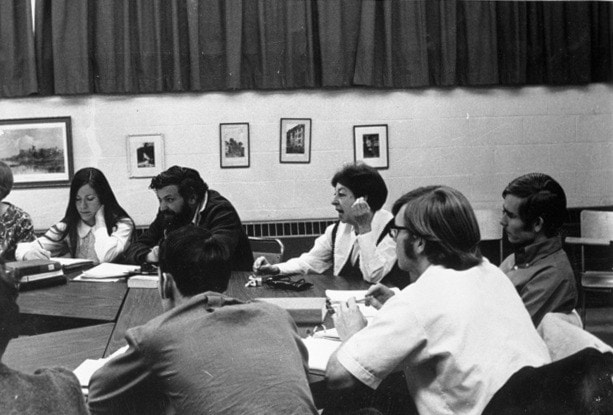First in a series
The City of Nelson has had a long history of involvement and support for university education in Nelson. Over a century ago Nelson leaders called for the province to build a university in Nelson. Nelson had the second degree-granting university in BC. It was a disaster for Nelson when the provincial government closed Notre Dame University in 1977 and its successor David Thompson University Centre in 1984. But the City of Nelson’s strong position and financial support helped maintain Nelson University Centre and the university library.
After the university closures, the City of Nelson’s position helped form and support Nelson University Centre. The city aspired to protect the library and to make university education once more available in Nelson. A university was considered to be important both economically and culturally for the community.
The important support given by the City of Nelson for university education is sometimes forgotten — as is the presence of the university library collection still in our midst. Today the Notre Dame/David Thompson University Library remains not only an important legacy of university education in Nelson and a sad page of injustice to Nelson and the Kootenay region but also an inspiration to re-establish a university based in Nelson.
Below: Roman Catholic Bishop Martin Johnson initiated Notre Dame College which later became Notre Dame University (Courtesy Touchstones Nelson)
 Here is my outline of that history.
Here is my outline of that history.
Nelson’s Notre Dame University began in 1950 as Notre Dame College. It was established by the Roman Catholic Bishop Martin Johnson and first offered only Grade 13 courses. In 1951, the college affiliated with Gonzaga University of Spokane and began offering first and second year arts and sciences programs. In 1952-53, the W.A.C. Bennett Social Credit government made the college eligible for federal operating grants.
In 1953-54, after a fundraising campaign, Bishop Johnson was able to acquire the Fairview campus land — the Tenth Street campus. Then began the first campus buildings: the classroom building (Patenaude Hall), the first student dormitory (La Sallette Hall) and the chapel. In 1960, the College was renamed Notre Dame University College and, in 1961, after affiliation with St. Francis Xavier University in Nova Scotia, it began offering third and fourth year courses.
A major step forward came on March 27, 1963 when the British Columbia legislature assembly chartered Notre Dame University as a private Catholic university with the power independently to offer degrees. NDU became the second university in British Columbia. In 1964, the BC Department of Education recognized the University’s education program and, in 1969, the Kootenay School of Art came to an agreement with the University that students could earn a bachelor of education or bachelor of fine arts taking their academic courses at the University and the fine arts courses at KSA. By the end of the 1960s, student enrolment was in the 500 to 600 range with nearly 60 faculty.
The library grew along with the university. In 1966, when I first came to Notre Dame University, the library consisted of some 30,000 books. It was housed in one of the large lower classrooms of the present Patenaude Hall. Books were piled to the ceiling for lack of space. In 1967, the university acquired some left-over army barracks from a location in Alberta. These buildings arrived as modules brought by trucks. They were dumped nearby on the campus parking lot.
A place behind the Patenaude building was cleared of trees and levelled. Students and professors assisted, as they had done for other work on the campus, in assembling the modules in their spare time and at noon hours.
I remember Mr. Baravalle, the registrar and assistant to the president, and helped him in laying in the foundation stones and making sure they were level. This was only to be a temporary structure. It was understood that a permanent building would be put up later.
A sketch of that hoped-for permanent building, by Nelson’s Fairbank Architects, hung for many years on the wall of the library. For now the temporary building would do.
When all was ready President Father Aquinas called for assistance in transferring the books from the basement of Patenaude to the new library. Students, faculty, and staff formed a long line of hands and so conveyed the entire collection one afternoon without losing a stitch in the order of the books from A to Z. What a wonderful achievement — everyone felt they had had a hand in building the library!
A ceremony was held in the fall of 1967 to mark the occasion. One sunny afternoon we gathered around the Library’s wooden steps to hear Cap Capozzi, chief donor of the building, speak and witness the consecration of the new facility by the Bishop of Nelson.
Years went by. The university grew and along with it so did the library.
NEXT: Notre Dame’s time of crisis
Dr. Arthur Bartsch, who received his PhD from the University of Chicago, taught history at Notre Dame University and David Thompson University Centre. In the years since he has been a leader in efforts to protect the university library and to re-establish a university in Nelson. He has worked and lived in Nelson for over 50 years.
